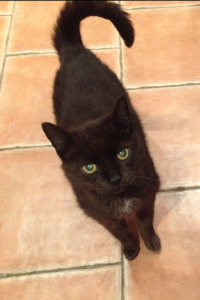News
Archive for December, 2012
Anxiety Relieving Products
by on December 3rd, 2012
Category: Special Offers, Tags:
Pet of the Month – December
by on December 3rd, 2012
Category: Pet of the Month, Tags:
Dudley has made a most amazing recovery from that dreaded condition, bloat. Gastric Dilatation-Volvulus (GDV), commonly called bloat, is an emergency medical condition that is seen most commonly in large and giant breed dogs. This is a life-threatening situation that occurs when the stomach fills with gas and/or food, expands, and then rotates, trapping gas inside the stomach and cutting off blood supply to the stomach and spleen. As pressure in the stomach builds up and cannot be released, the stomach tissue becomes necrotic (dies) and the stomach can even rupture. The expansion of the stomach also has a serious effect on the heart and lungs, causing difficulty breathing and abnormal heart rhythm. Most dogs will go into shock soon after the signs of GDV are seen. Death can occur within a matter of hours (or less). The most common signs of GDV include the following:
- Distended (bloated) abdomen
- Unproductive retching / heaving
- Extreme lethargy
Dudley’s bloat was so bad that not only did his stomach need decompressing but his spleen also needed to be removed, which in turn necessitated a blood transfusion. We are thrilled to report that he is now back to his normal charming self!
Spot the Signs
by on December 3rd, 2012
Category: News, Tags:
 According to the latest veterinary research, and thanks to medical advances as well as to improvements in healthcare, cats are now living longer than ever. Ninety per cent of vets have now treated cats aged 22 or above – that’s equivalent to 104 in human years! Did you know that if your cat is over the age of 7 they are classed as ‘mature and older’? Of course, it’s fantastic that our furry friends are around for longer, but if your cat is one of the 46 percent of Britain’s ‘mature and older’ moggies then you need to be extra aware of the signs of chronic pain. Just like humans, the years can take their toll on a cat’s joints and your cat is more at risk of developing age-related health conditions, such as arthritis. Cats live very active lives and are natural athletes. As they get older, their joints can suffer with wear and tear. Arthritis causes joints to degenerate over time, which can result in chronic pain and reduced mobility.
According to the latest veterinary research, and thanks to medical advances as well as to improvements in healthcare, cats are now living longer than ever. Ninety per cent of vets have now treated cats aged 22 or above – that’s equivalent to 104 in human years! Did you know that if your cat is over the age of 7 they are classed as ‘mature and older’? Of course, it’s fantastic that our furry friends are around for longer, but if your cat is one of the 46 percent of Britain’s ‘mature and older’ moggies then you need to be extra aware of the signs of chronic pain. Just like humans, the years can take their toll on a cat’s joints and your cat is more at risk of developing age-related health conditions, such as arthritis. Cats live very active lives and are natural athletes. As they get older, their joints can suffer with wear and tear. Arthritis causes joints to degenerate over time, which can result in chronic pain and reduced mobility.
Unlike dogs and humans, cats don’t generally show signs of lameness. The signs of chronic pain are much more subtle – that’s why Cat Pain Awareness Month is so important. In this newsletter, there is expert advice to help you spot the signs of chronic pain in your cat, as well as tips to help your cat live into old age as comfortably as possible. Don’t forget to also check out the Facebook page to show your support: www.facebook.com/spotcatpain
If you haven’t already, why not take advantage of Cat Pain Awareness Month to think about your cat’s health, especially any physical or behaviour signs that could signify your cat isn’t at their spritely best. Claire Bessant, leading feline author gives this advice: “We have devised five simple questions to help you spot the behaviour changes that could indicate your cat is in pain. If you answer yes and think your cat could be suffering from chronic pain, it is best to consult your vet for advice.”
- My cat’s behaviour has become more agitated then usual – have you noticed changes in your cat’s attitude or daily routine?
- I have noticed changes in my cat’s grooming habits – have you noticed deterioration in your cat’s appearance, with a matted or scruffy coat?
- My cat is sleeping more than usual – Have you noticed your cat slowing down, sleeping more, or moving stiffly?
- I have noticed my cat hesitating to jump up or down – Have you noticed your cat hesitating, or being more reluctant to jump up or down onto your lap/onto the furniture/through a cat flap?
- My cat has become withdrawn – Have you noticed changes in your cat’s temperament?
“Cats are programmed by evolution not to show obvious signs of pain to protect themselves from prey. Unlike dogs, they rarely cry out or limp, preferring instead to hide and shy away from contact. Dog owners are more likely to notice pain during routine walks, whereas a cat will just move less to limit its pain, and can often be seen as a cat just getting old,” says Vicky Halls, cat behaviour counsellor.
But don’t worry – there is treatment available that is licensed for long term use in cats with arthritis. This can help manage the pain and inflammation associated with arthritis, allowing your cat to make the most out of life.
If you have any questions, or are concerned that your cat might be in pain, please contact the surgery and speak to your vet for help and advice about what to do. Remember, you know your cat better than anyone, so are best placed to spot any of the subtle signs that indicate that your cat is suffering with chronic pain.



